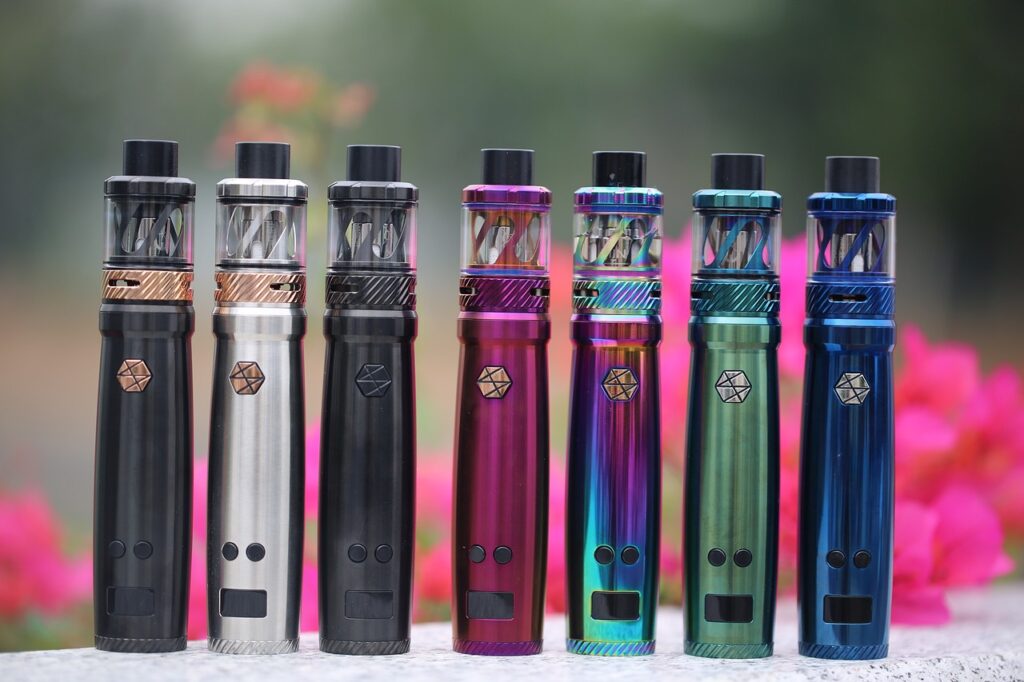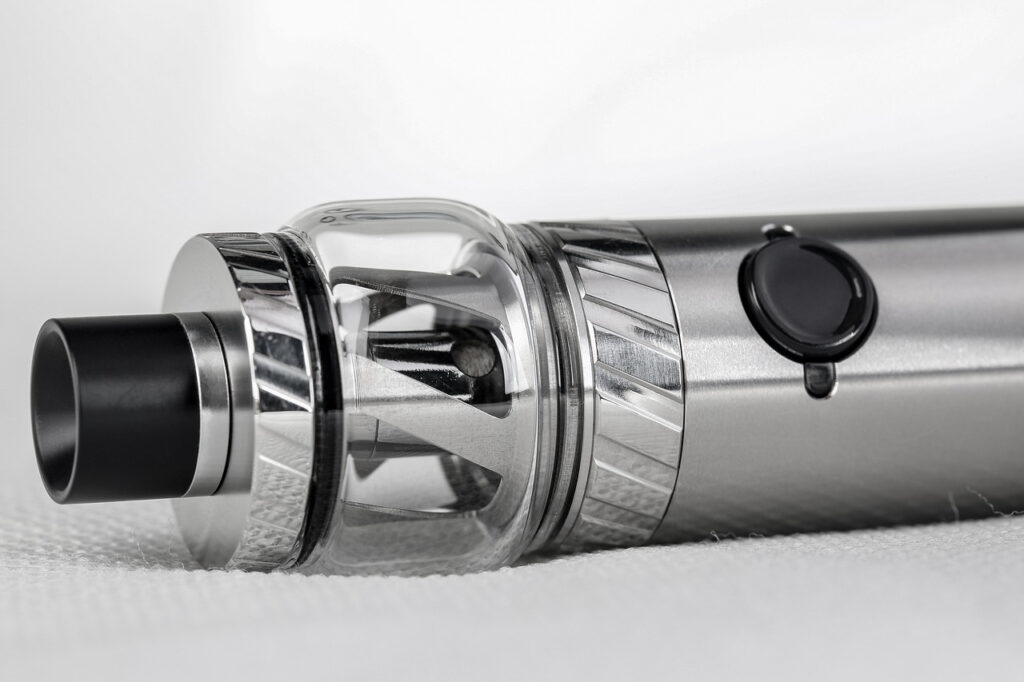In the past decade, vaping products have become increasingly popular as an alternative to traditional smoking and are becoming a global public health concern.
Though their long-term effects are still under investigation, the early findings are pretty alarming.
With sleek designs and a plethora of flavours, such as grape, watermelon, vanilla, bubble gum and tutti fruity, e-cigarettes have attracted not only long-time smokers seeking what they think is a healthier option to smoking but also young adults and even children.
Delivery devices resembling school stationery and colourful toys have even been manufactured in China and exported worldwide.
Starting from the 1st of October 2021, e-cigarettes and e-liquids containing nicotine were supposed to be only available in Australia with a prescription.
However, the law was not effectively enforced and products were readily available in high-street stores and petrol stations, sold ‘under the counter’ in an unregulated black market.

Beneath the trendy exterior lurks a host of health risks that are often overlooked
How Did The Vaping Industry Start?
It appears the concept of vaping began back in 1930 with Joseph Robinson’s patent or in 1965 with Herbert A. Gilbert’s patent, both of which referenced what might be considered primitive e-cigarettes.
Decades later, in 2003, the first commercially successful e-cigarette was invented by a Chinese pharmacist, Hon Lik, following the death of his father as a result of his smoking habit.
Lik is widely credited as the inventor of the modern e-cigarette and the father of vaping as we know it today.
Thereafter, the US, UK and Australia followed suit in the mid-2000s. Since then, the design of e-cigarettes has evolved extensively in the last few years.
From the original “cig-a-likes” because of how closely they resembled cigarettes to the latest generation devices the size of a USB stick, like the now obselete “Juul” and beyond, they have all been marketed as a safer alternative to conventional tobacco products.
Atomiser Anatomy
Electronic cigarettes (or e-cigarettes) are battery-operated devices that heat a liquid that may or may not contain nicotine, termed electronic nicotine delivery systems (ENDS) or non-nicotine electronic delivery systems (NNENDS), respectively.
Both comprise a cartridge containing ‘e-liquid,’ an atomiser (which contains a heating element), a battery and a mouthpiece.

E-cigarette Liquid Components
The presence of harmful substances in e-cigarette vapour, produced from “e-juice” is well documented and includes the following:
| Constituent in “e-juice” | What else are these chemicals found in? |
| Nicotine | Nicotine is a highly addictive chemical compound present in the tobacco plant and in cigarettes. It is also found in gum, mouth spray, lozenges and inhalators that are used as an aid in withdrawal from tobacco smoking. The nicotine content of e-liquids and ranges from none (nicotine-free) up to 36mg/ml or higher. To avoid a burning sensation in the throat during that characteristic “throat hit” during inhalation associated with higher nicotine-containing devices, vapes may also contain a coolant chemical called N,2,3-trimethyl-2-isopropylbutamide or WS23. |
| Ethylene glycol, propylene glycol & glycerol | These are humectants (meaning, they preserve moisture) and are common additives during food processing. Ethylene and propylene glycol are also used to make products like anti-freeze, paint and artificial smoke in fog machines. |
| Acetylaldehyde | Acetaldehyde is primarily used as an intermediate in the manufacture of a range of chemicals, perfumes, aniline dyes, plastics, synthetic rubber and some fuel compounds. |
| Formaldehyde | Formaldehyde (CH₂O) is a colourless, highly toxic and flammable gas at room temperature. It is used in the production of fertiliser, paper, plywood and some resins. It is also used as a food preservative and in household products, such as antiseptics, medicines, cosmetics and even for embalming dead bodies. |
| Flavourings containing Diacetyl & Benzaldehyde | There are more than 7500 flavours available. Diacetyl is a buttery-flavoured chemical in foods like popcorn, caramel and dairy products. The different candy flavours could contain over 30 different chemicals. |
| Acrolein | This is a chemical used to control plant and algae growth in irrigation canals. It also kills microorganisms and bacteria in oil wells, liquid hydrocarbon fuels, water-cooling towers and water treatment ponds. |
| Benzene | A volatile organic compound found in car exhaust fumes. |
| Toxic elements | Arsenic, cadmium, chromium, manganese, lead, nickel and tin. |
Vaping products can also be used to aerosolise tetrahydrocannabinol (THC) and cannabinoid (CBD) oils.

Haunting Health Hazards
Vaping can have several deleterious effects on all bodily systems other than the noticeable effects on the respiratory system:
| Body System Involved | Adverse Effects to Health |
| Respiratory | Other than exacerbating conditions such as asthma and COPD, the pulmonary risks of vaping are rapidly emerging, with the most immediately alarming being the condition of Electronic-cigarette/Vaping-Associated Lung Injury (EVALI) that was first recognised in 2019. This condition is characterised by cough, breathlessness, chest pain, nausea, vomiting, diarrhoea, fever and weight loss. Due to levels of diacetyl, there is increasing evidence that chemical gives rise to a condition known as bronchiolitis obliterans, an irreversible scarring of the tiny air sacs in the lungs resulting in the thickening and narrowing of the airways. Otherwise known as “popcorn lung“, this term was derived after workers at a factory that packaged microwave popcorn contracted the disease after inhaling this chemical. Diacetyl is responsible for the buttery-flavoured chemical in foods like popcorn, caramel and dairy products. Years later, it was banned from all food products. |
| Cardiovascular | Though research is evolving, vaping has been linked to cardiovascular diseases. Nicotine, which is present in most e-cigarettes, increases heart rate and blood pressure. Over time, this can lead to a higher risk of heart disease and stroke. Moreover, the particles in e-cigarette vapour can damage the cells lining the blood vessels, impairing their function and potentially leading to cardiovascular disease. |
| Gastrointestinal | Accidental or intentional ingestion of e-liquids containing nicotine can cause poisoning, leading to symptoms such as nausea. vomiting and severe abdominal pain. |
| Neurological | The University of Nevada has been conducting research regarding the potential neurological impacts of vaping. The institution found that young adults who vape are more likely to report memory, attention, poor impulse control and mental health problems. This is particularly concerning given the popularity of vaping among young people, whose brains are still developing until their mid-to-late 20s. |
| Reproductive | Vaping during pregnancy will have serious adverse effects on foetal development, just like conventional smoking causing pre-term and low birth weight, stillbirth and Sudden Infant Death Syndrome (SIDS). Nicotine also affects brain development in utero. |
| Oral Health | A study in the Journal of Oral Pathology & Medicine reported that e-cigarette use could cause oral cellular changes, leading to diseases like periodontitis and oral cancer. Nicotine in e-cigarettes also contributes to dry mouth and increased plaque, which can accelerate tooth decay. |
Secondhand And Thirdhand Vapour Vs. Secondhand Cigarette Smoke
The jury is still out as to whether secondhand exposure to e-cigarette vapour is less toxic than secondhand exposure to cigarette smoke.
However, though the secondhand vapour is often odourless or even sweet-smelling, it is still considered a form of air pollution that probably poses a health risk. It contains nicotine, ultra-fine particulate matter and volatile organic compounds (VOCs) at concentrations that are above recommended levels.
In addition, when someone vaping exhales, thirdhand exposure can also occur when nicotine and other chemicals from secondhand smoke deposit on surfaces, such as walls, tables, floors and even clothes, further exposing people.
Therefore, one may be exposed to these components when one touches a contaminated surface.
E-Cigarette “Ecocide”
Vaping isn’t just a cloud of concern on personal health, but it also is a huge environmental concern. Used devices present a triple environmental threat: plastic, electronic and hazardous chemical waste.
The issue of e-cigarette waste exemplifies a broader environmental challenge. Specifically, within Australia, neither federal nor state legislation currently regulates the disposal of e-cigarettes at the end of their life cycle.
Vape and e-cigarette cases are also made of plastic. They can’t be recycled because they may contain liquid nicotine, which is a hazardous substance. So, unfortunately, they end up in regular household trash or littering our pavements, parks and beaches.
Cast into the environment, the plastic they are made of will take hundreds of years to break down into ever-smaller pieces, finally ending up as micro- or nano-plastics. These can be ingested by animals, birds and marine life, resulting in their death.
(For my separate publication on the environmental issues arising from microplastics, click here).
On the other side of the world, research by recycling campaigners Material Focus in the UK revealed that the number of disposable single-use vapes thrown away has soared from 1.3 million to nearly five million per week.
This is equivalent to eight per second being thrown away – almost four times the number since the research was first conducted in 2022. Per annum, the amount of vapes thrown away would be enough to cover an area the size of 22 soccer pitches.
The same organisation quoted that single-use vapes contain, on average, 0.15g of lithium. So, with over 1.3 million single-use vapes thrown away in the UK every week, this accumulates to 10 tonnes of lithium a year, equivalent to the lithium in batteries inside 1,200 electric vehicles.
Furthermore, lithium batteries are at risk of fire or explosion if they are damaged or submerged in water.
Veolia, the largest waste management company in the UK, recently launched a nationwide fire-safe vape-recycling scheme where retailers are supplied with containers of vermiculite.
This hydrous phyllosilicate mineral undergoes significant expansion when heated. Therefore, when lithium batteries are transported surrounded by this mineral, the risk of combustion is minimised.

Australia Admirable Advancement For Change
Australia has a history of combatting smoking and enforcing stringent tobacco regulations.
In 2012, it became the first country to introduce plain cigarette packaging laws. Countries like France, the UK, New Zealand, Norway and Ireland have since adopted this policy.
Moving forward, in a decisive move to curb the proliferation of vaping among youths, the Australian government has launched a comprehensive clampdown on the availability of vapes, with new regulations taking effect as of the 1st of January 2024.
These measures aim to close the loopholes in previous legislation that permitted the widespread distribution of addictive and potentially harmful vaping products, often deceptively marketed to minors.
Children are not taking up vaping as an alternative to conventional smoking. Vaping products are being presented in a novel form in an attempt to breed a younger generation of nicotine addicts.
Once hooked, many of them may go on to start smoking later in life.
Under current regulations, the legal sale of nicotine-containing vapes in Australia is restricted to pharmacy access with a health professional’s prescription.
However, private importation was permissible with a valid prescription and the vaping industry exploited this gap to sell nicotine-laced products to young users under the guise of being “nicotine-free”; a claim only verifiable through costly and time-consuming laboratory testing.
Consequently, enforcing nicotine standards was an almost insurmountable challenge against an industry intent on hooking a new generation.
The revamped legal framework makes enforcement more straightforward. It aims to restrict easy access to vapes, which has been the primary obstacle to preventing vaping, especially in young people.
3 Steps For Success
The reforms in Australia will occur in three stages:
1. Ban on import: Effective from the 1st of January 2024, the government prohibited the importation of all disposable, single-use vapes. Starting March 1, 2024, the importation of all vapes will require a license and permit, and the Personal Importation Scheme will be terminated, mandating all vaping products be accessed through Australian pharmacies with a prescription.
This embargo has already been implemented. On the 30th of January, the Australian Border Force (ABF) seized more than 13 tonnes of disposable vapes from entering the community from several air cargo consignments in the city of Adelaide. In total, the 150,000 vapes have an estimated potential street value of more than $AUD 4.5 million.
2. Domestic Manufacture and Sales Ban: Scheduled for late 2024, this phase will eradicate the retail sale of all vaping products outside the prescription framework.
This action necessitates changes to the Australian Therapeutic Goods Act 1989, which is anticipated to be reviewed by the Federal Parliament in the latter months of 2024.
3. Prescription Access: As of the 1st of January 2024, a broader spectrum of medical professionals, including medical and nurse practitioners, are authorised to prescribe vapes for smoking cessation or nicotine dependence management.
By March 1, 2024, stricter regulations will come into effect, setting standards for therapeutic vape products regarding nicotine content, permissible flavours and standardised medical packaging.
The regulatory overhaul ensures that while therapeutic vaping remains accessible under prescription, it is essential to recognise that these products are unapproved medicines, not subject to the rigorous safety and efficacy evaluations of other validated smoking cessation aids.
One day, Australia may even join one of 35 countries where vaping is claimed to be totally “illegal”.
The country can only hope that restricting access to vaping products will not inadvertently cause a resurgence in the prevalence of smoking tobacco. After all, lung cancer continues to claim the lives of over 9,000 Australians annually, including the tragic minority who have never even tried a cigarette.
Should this occur, the Federal Government’s plan to strive for cleaner and healthier air will have totally gone up in smoke.
This also means that controversial Australian organisations like “Legalise Vaping” which deem vaping as a “safer” alternative for natural risk-takers who would have taken up smoking anyway, may have some validity in their argument.
In any case, the safest and most prudent option would be to avoid both altogether.
Thoughts and comments are welcome.
(Contact Quitline for help to quit smoking or vaping. You can call the hotline on 13 QUIT (13 7848) to talk to a counsellor or request a callback)
Kindly reproduced for educational purposes only from an Australian (ABC) documentary
10 responses to “Vaping Veto: What’s New For Australia In 2024?”
-
Very interesting. I’m surprised it started that far back. I was very fortunate to have stopped by myself. Surprisingly, I didn’t find it all that hard. Thanks for the informative read.
-
Thank you – yes, during my research, I also thought vaping was a 21st-century thing. But clearly not! I am glad you kicked the habit, as you have many wonderful years left to live for sure 🙂
-
-
Interesting (and depressing) read. Touted as a healthier alternative to help smokers quit, it’s alarming that I see many people who were not smokers, now vaping. Especially given there’s so little research into the effects of the chemicals involved. That’s before we even start considering the environmental damage from discarded vape canisters. Excellent article, Paul!
-
Absolutely – and being a schoolteacher, you will know that these companies are specifically targeting a vulnerable, easy-influenced population such as children. Other than “gaming” etc., it’s becoming a new form of addiction. It was also shocking to read on my local community forum page that “vapes” were being sold under the counter at a nearby lolly shop.
-
-
That was very interesting, Ive always been curious about vapes. How they’ve now gone global from a single invention for a supposedly healthier alternative to cigarettes, yet they’re far more poisonous than I realised which is a shame really.
-
Lynton, absolutely. Though the “smoke” emanating from vapes at first seem innocuous, you can now see how noxious the contents of the vapour actually are. Thank you for your thoughts.
-
-
Very insightful and well-written article. Hope it will help many people!
-
Harpreet, thank you for reading.
As you know, it’s exactly young people like you that the vaping market is targeting. But clearly, you’re far too sensible to even contemplate taking this habit up.
-
-
Très bon article. Bravo. Heureusement que je ne fume ni cigarettes ni e-cigarette.
-
Jérémie, thank you for reading and commenting. I’m glad you haven’t become a victim of either.
-














Leave a Reply to Don Biltcliff Cancel Reply